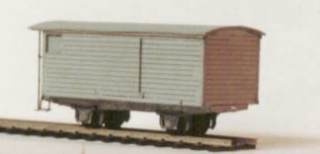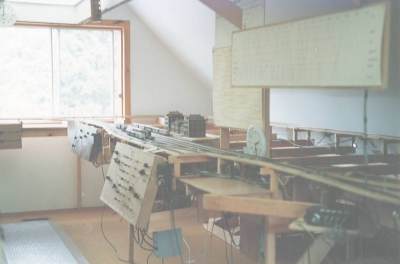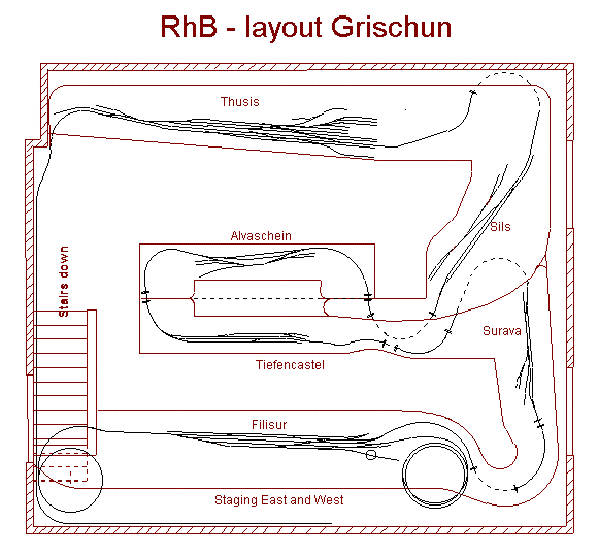|
How I became interested in the RhB
|
|
|
|
|
|
|
|
|
Spending ten months in the Engadin at the age of seven provided the first contact with the RhB. The city of Zürich has a convalescence home for children suffering from asthma located at Celerina.
At that time (1952) the modernization was only just beginning. The first batch of Ge 4/4' (601-604) were in service, but the "Kroks" and the other, even older, rod type engines still handled the bulk of the traffic.
The ABe 4/4 railcars (501-504) were used together with the first lightweight cars in what was then called the "Flying Rhaetian".
It was a fascinating time, many a night we would sneak out of bed to crack the shutters just enough to see the late train going by - the home is located next to the RhB line - amid a rain of sparks from the iced up catenary.
|
|
|
|
|
Of course I had always been intrigued by trains and already had an electric train set at that time, but the SBB (Swiss federal railways) standard gauge lines were more accessible as a prototype and it would be 24 years later that modeling the RhB finally started in earnest.
|
|
|
|
|
During the summer of 1976 we spent four weeks in Switzerland. Having purchased Swiss Holiday passes we rode the trains everywhere!
The Grisons generally, and the Engadin in particular, being my favourite parts of Switzerland we spent many hours on the RhB.
Purchasing a recently published book on the RhB complete with drawings and lots of pictures meant scratch building was now possible even in faraway Ontario, Canada. All the models were built in HO scale to run on 12 mm track gauge (TT).
|
|
|
|
|

|
Gk 5217
First scratchbuilt model in HOm, partially finished. Lettering and detail parts (brakehoses, handrails, couplers etc. etc.) still missing.
|
|
|
|
|
BEMO had just started offering HOm models of German prototype complete with track components, but it would take a little while longer before the RhB items started coming from Uhingen.
From 1976 to 1981 the RhB Narrow Gauge was only a very minor part of a sizeable freelanced SBB layout.
This changed when we moved in 1981 and I now had a 8.8m by 8.8m (29ft x 29ft) room for my layout. Unfortunately the room was unfinished and it would take four years to get to the layout building stage.
|
|
|
|
|
The combined station of Chur-Filisur, Dec. 1986.
The layout already had walk-around cabs, fast clocks, full scheduling complete with timetables and employee timetables.
Enough action to keep 8 people busy!
|

|
|
|
|
Eventually the room would be filled with HOm RhB trackage from one end to the other! When the layout was at its peak (1992) with the Albula mainline and two additional branchlines it would require 13 people to run a full operating session.
It was simply TOO MUCH!
|
|
|
|
|
The track plan of the scaled back, simpler version follows.
|
|
|
|
|

|
|
|
|
Major changes happened in 1998. The property was up for sale and the layout was gone by early 1999.
Parts of it found a new home in Florida, other parts are still in storage. The rest was discarded, much to the dismay of my friends! Admittedly it is hard to understand how perfectly good, handlaid track could be going to the landfill. For pictures of “what used to be” click here.
|
|
|
|
|
|
|
|
The new layout is in a much larger scale and will be mostly outside.
|
|
|
|
|
|
|
|
Model railway in the garden
|
2015/05/04
|
|
|
|
|
|
|
It grew according to plans and as the years went by those plans underwent modifications. Possible improvements are always a wise choice, especially when everything is a brand new “discovery”.
|
|
|
The basic concept remained the same; a point to point railway. What changed, and was reduced, were the high flying plans of using the whole garden, including the part out the front. That and the realization that progress would be a lot slower than anticipated.
|
|
|
The awakening to what was commercially available at what price and what accuracy to real 1:22.5 scale did the rest. Scratch building was a given and the time plan became correspondingly longer.
|
|
|
Generating the required scale drawings took a lot of additional time, but at the same time assured unique models instead of the cookie-cutter commercial ware. Learning from others on how to do it a bit easier, more solid and with different materials was still in the cards. without reinventing the wheel.
|
|
|
How hat was built und created you will find in the many pages of this site. Just keep in mind, it’s a work in progress. Slowly, but surely. Almost like they used to buil in the “Good old days”.
|
|
|
I hope you enjoy browsing the pages. Pop by from time to time and check on what is new on this page .
|
|
|
|
|
|
|
|
HJ
|
|
|
|
|
|
|
|
|